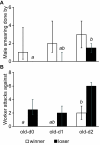The dynamics of male-male competition in Cardiocondyla obscurior ants
- PMID: 22703760
- PMCID: PMC3424134
- DOI: 10.1186/1472-6785-12-7
The dynamics of male-male competition in Cardiocondyla obscurior ants
Abstract
Background: The outcome of male-male competition can be predicted from the relative fighting qualities of the opponents, which often depend on their age. In insects, freshly emerged and still sexually inactive males are morphologically indistinct from older, sexually active males. These young inactive males may thus be easy targets for older males if they cannot conceal themselves from their attacks. The ant Cardiocondyla obscurior is characterised by lethal fighting between wingless ("ergatoid") males. Here, we analyse for how long young males are defenceless after eclosion, and how early adult males can detect the presence of rival males.
Results: We found that old ergatoid males consistently won fights against ergatoid males younger than two days. Old males did not differentiate between different types of unpigmented pupae several days before emergence, but had more frequent contact to ready-to-eclose pupae of female sexuals and winged males than of workers and ergatoid males. In rare cases, old ergatoid males displayed alleviated biting of pigmented ergatoid male pupae shortly before adult eclosion, as well as copulation attempts to dark pupae of female sexuals and winged males. Ergatoid male behaviour may be promoted by a closer similarity of the chemical profile of ready-to-eclose pupae to the profile of adults than that of young pupae several days prior to emergence.
Conclusion: Young ergatoid males of C. obscurior would benefit greatly by hiding their identity from older, resident males, as they are highly vulnerable during the first two days of their adult lives. In contrast to the winged males of the same species, which are able to prevent ergatoid male attacks by chemical female mimicry, young ergatoids do not seem to be able to produce a protective chemical profile. Conflicts in male-male competition between ergatoid males of different age thus seem to be resolved in favour of the older males. This might represent selection at the colony level rather than the individual level.
Figures





Similar articles
-
Imperfect chemical female mimicry in males of the ant Cardiocondyla obscurior.Naturwissenschaften. 2008 Nov;95(11):1101-5. doi: 10.1007/s00114-008-0430-8. Epub 2008 Aug 5. Naturwissenschaften. 2008. PMID: 18679638
-
Mating success and potential male-worker conflict in a male-dimorphic ant.BMC Evol Biol. 2007 Jul 10;7:114. doi: 10.1186/1471-2148-7-114. BMC Evol Biol. 2007. PMID: 17623070 Free PMC article.
-
Competition and opportunity shape the reproductive tactics of males in the ant Cardiocondyla obscurior.PLoS One. 2011 Mar 29;6(3):e17323. doi: 10.1371/journal.pone.0017323. PLoS One. 2011. PMID: 21468323 Free PMC article.
-
Fitness and aging in Cardiocondyla obscurior ant queens.Curr Opin Insect Sci. 2016 Aug;16:58-63. doi: 10.1016/j.cois.2016.05.010. Epub 2016 May 18. Curr Opin Insect Sci. 2016. PMID: 27720051 Review.
-
Life-history evolution in ants: the case of Cardiocondyla.Proc Biol Sci. 2017 Mar 15;284(1850):20161406. doi: 10.1098/rspb.2016.1406. Proc Biol Sci. 2017. PMID: 28298341 Free PMC article. Review.
Cited by
-
Lethal Male Combat of Anastatus japonicus (Hymenoptera: Eupelmidae), an Egg Parasitoid of Lepidopterous and Hemipterous Pests.Insects. 2025 Jan 6;16(1):45. doi: 10.3390/insects16010045. Insects. 2025. PMID: 39859626 Free PMC article.
-
Trade-offs between immunity and competitive ability in fighting ant males.BMC Ecol Evol. 2023 Aug 7;23(1):37. doi: 10.1186/s12862-023-02137-7. BMC Ecol Evol. 2023. PMID: 37550612 Free PMC article.
References
-
- Andersson M. Sexual Selection. Princeton University Press, Princeton, NJ; 1994.
-
- Hölldobler B, Bartz SH. In: Experimental Behavioral Ecology and Sociobiology. Hölldobler B, Lindauer M, editor. Academic, New York; 1985. Sociobiology of reproduction in ants; pp. 167–220.
-
- Heinze J, Cremer S, Eckl N, Schrempf A. Stealthy invaders: the biology of Cardiocondyla tramp ants. Insect Soc. 2006;53:1–7. doi: 10.1007/s00040-005-0847-4. - DOI
-
- Kinomura K, Yamauchi K. Fighting and mating behaviors of dimorphic males in the ant Cardiocondyla wroughtoni. J Ethol. 1987;5:75–81. doi: 10.1007/BF02347897. - DOI
-
- Hamilton WD. In: Diversity of insect faunas. Mound LA, Waloff N, editor. Blackwell Scientific, Oxford; 1978. Evolution and diversity under bark; pp. 154–175.
Publication types
MeSH terms
Substances
LinkOut - more resources
Full Text Sources

